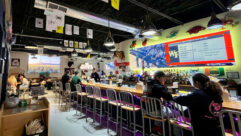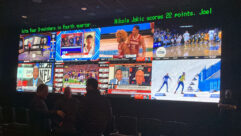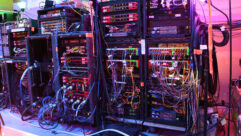
Managing AV Gear On The Network
The past decade has seen challenges arise for AV consultants and integrators as AV systems have proliferated across campuses, cities, and even continents. The difficult task of monitoring, controlling, and keeping track of all this gear has become somewhat easier as a result of its migration to the network.
The past decade has seen challenges arise for AV consultants and integrators as AV systems have proliferated across campuses, cities, and even continents. The difficult task of monitoring, controlling, and keeping track of all this gear has become somewhat easier as a result of its migration to the network. With a well thought-out system design, AV facility support staff, AV technicians and operators, or IT technologists can use managed control systems to remotely support, operate, test, and monitor AV systems.
Deploying a managed control system for companies with multiple AV facilities can streamline operations, improve end-user support, ensure reliable operations, and assist with AV systems maintenance and testing. The key is to implement a centralized, Web-based AV control and monitoring portal, allowing managers and technicians to remotely view, monitor, and control the systems.
A managed control system (MCS) lets administrators and support staff manage AV resources, perform remote system diagnostics, track projector lamp use, log network activity, and automate tasks through event scheduling. For example, select rooms can be locked out to prevent unauthorized use of TVs, CD players, and other AV equipment.
With the help of a managed control system, any AV system or facility can be organized by region, country, state, building, floor and room, providing easy access to hundreds of devices and systems.”/>
With the help of a managed control system, any AV system or facility can be organized by region, country, state, building, floor and room, providing easy access to hundreds of devices and systems.
This system also can track any AV control function, including lights, audio levels, motion detection, temperature, and more. Interactive help-desk capabilities let users send requests from their touchpanels or Web browsers. Support staff can send instant text messages back to the touchpanel, alert e-mail contacts, and even control the room and its AV equipment.
These systems can manage all AV devices and control functions throughout a facility with hundreds of rooms. This lets staff log on and perform system tasks while limiting their access to restricted areas, automatically sending e-mail alerts to any number of recipients based on their assigned status — all from any computer connection on the network. Organizations can quickly determine equipment and purchasing needs, user activity, and room usage by using built-in logging, report, and chart generation. Tasks that typically take days to complete are reduced to a few mouse clicks with a managed control system.
For the context of this discussion, remote control refers to control from a location not physically in the same space as the AV facility being controlled. Let’s take a look at some useful tips and tricks for managing AV gear on the network.
Getting Started
To build an MCS, each AV system introduced into the network must be local area network (LAN) enabled. Most control system manufacturers offer products that will make an AV system network enabled. This usually involves a mainframe AV processor that connects to the LAN, and then is configured to control various devices in the system. Ancillary devices or systems can include lights, shades, screens, switchers, video displays, VCRs, DVDs, and volume controls, among others.
Connecting to the Network
Next comes the hard part. Working with the end user’s IT staff, the processor needs an IP address that is accessible and can be “pinged” from within the network. Most IT networks include security features that allow IP addresses to be provided only if you are properly logged into the network. In wide area network (WAN) environments, this becomes a bit more difficult, since IP addresses must be accessible from any point (desktop PC) on the network. This could mean access across buildings, cities, or countries.
Despite the fears of many IT personnel, the impact of control systems on the network (LAN/WAN) is minimal. Consider that an e-mail message with a 1MB attached PowerPoint presentation will send approximately 1,000 packets of 1KB each and takes about three to four seconds to transmit 1,000,000 bytes. By comparison, AV IP traffic is minuscule, as most AV commands will use less than 50 bytes of network traffic. All Web pages and device commands are in the box and easily accessed from any Web browser.
The AV processor can provide information over the network, which can report on equipment status and operation.
In addition, touchpage emulation pages can be delivered that offer true offsite control of the AV system, typically from a Web browser.
Certain devices, such as video projectors, also can connect directly to the network (again, requiring a static IP address) and can give feedback such as status, input selected, and lamp life without the need for an AV control processor. These devices have built-in electronics that “fess up” Web pages directly.
As more and more AV system endpoints are brought onto the network, a list of IP addresses associated with each system grows. Most AV departments will add IP addresses to their databases of useful room information, such as name, location, ISDN numbers, and the like.
The Tree
A useful tool in organizing room IP destinations is using a simple HTML Web page to create a sidebar “tree” of each AV system, featuring subdirectories by building, city, state, country, or region. This makes navigating through numerous AV systems quick and easy.
On the tree, an AV system is selected by clicking on the sidebar. Room controls, equipment status, and other parameters are displayed in the mainframe. Subfolders can be used to organize facilities by region, country, state, building, floor, and room, providing easy access to hundreds of AV systems.
Most control system manufacturers make products that allow easy access to devices and systems via IP addressing.
Another simple means of managing the list of IP locations is to organize each one as a Web page within “favorites” from any browser.
Add a Camera
Another interesting feature you can add to the managed control system is the ability to see into each AV system via a Web camera or Web server (another IP address will be required), giving a look into the conference room.
For videoconference systems, this means taking the video camera output and feeding a Web server appliance from the matrix switcher. The video is embedded in a Web page; it’s a fairly low-resolution image but more than adequate for monitoring. Most technicians find this an invaluable tool when remotely setting up and assisting users.
Adding a camera raises some privacy and security concerns. To make matters more interesting, audio monitoring could be available if the rooms are equipped with table microphones connected to an (audio) Web server. There are methods of muting both audio and video feeds from a room that can ensure privacy and maintain meeting confidentiality.
AV Help Desk
A managed control system is the ideal tool for an AV help desk. Users can call the help desk, and a technician immediately assists them without getting up from his or her chair. The technician can take control of the AV system and have the meeting up and running within seconds.
Christopher Maione, CTS-D, is a principal with CMS Innovative Consultants in Mellville, N.Y., and adjunct instructor for InfoComm International. He can be reached at [email protected].










